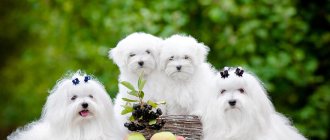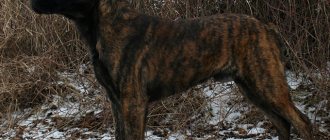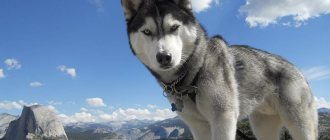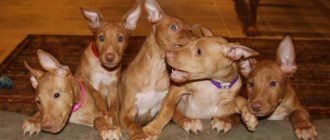| Intelligence: |
| Aggressiveness: |
| For security: |
| For children: |
| Training: |
| Difficulty in care: |
The historical country of origin of the water dog is Spain. There are two versions of the origin of this breed. The first version says that the Spanish water dog came to the islands of Spain along with Turkish traders. The second says that the breed came from Africa. There is an ancient official source that testifies to their residence in the Iberian Islands since 1110.
The water dog is the ancestor of all modern water dogs. Previously, it was bred to protect pastures and also helped fishermen get fish from the river. Very often the water dog worked in the mountains. Now she is used as a companion dog.
general characteristics
The Spanish Water Dog has a distinct and original appearance:
- The head is powerful.
- Flat skull.
- The eyes are brown.
- The nose matches the color.
- Drop, triangular ears.
- The neck is short and muscular.
- Wide chest.
- The straight back is formed by strong muscles.
- The paws are strong, with pads reminiscent of a cat's.
- Docked or stubby tail.
- The coat in puppyhood is short and curly. In adults, it is twisted into original cords.
- Color can be white, brown or black.
- Males at the withers reach 50 cm, females - 45 cm.
- Males weigh up to 20 kg, females up to 16 kg.
Kinds
Inuit is a dog classified as a Spitz. These include breeds of a primitive type, close to aboriginal ones.
The breed has no subspecies. However, due to the lack of a clear standard, the Utonagans are classified as Inuit. Their difference is considered to be their smaller size. Utonagans are shorter than 59 centimeters at the withers.
Utonagan dogs are often classified as Inuit.
Inuit are also divided by color. In particular, the sable pattern is acceptable in all variations, even on a white background. The sable's coat is distinguished by darkening along the back and face. The sides and bottom of the paws are often highlighted. The main tone can be peach, brown, almost black. The transitions between color fragments are smooth. There are no clear spots.
Character
The Spanish Water Dog is an excellent companion that is suitable for the whole family. By nature they are very affectionate, calm and friendly. They lack any aggression. They treat strangers quite loyally if there is no danger, but they prefer to stay away from strangers. Water Spaniards get along well with children and are ready to play active and noisy games with them.
It is not recommended to leave them alone with young children. Quite by accident, they can cause them pain, since they are very mobile and cannot sit still.
These dogs need a person and do not tolerate loneliness well . Out of boredom, they can become a little mischievous at home, and the owner is unlikely to be happy about this. They get along well with other animals, can even make friends with them and will not share their territory.
Spanish Water Dogs have natural endurance and are happy to accompany you on your morning jog or bike ride. They boast excellent hearing and sense of smell and are ready to sense or hear sounds and smells over long distances.
But the greatest pleasure in the world for these dogs is water. They are ready to swim 24 hours a day, in any small river or pond. In this connection, small problems may arise, since water Spaniards will not miss more than one puddle and will have to be washed more often than usual. Therefore, in rainy and dirty weather it is better to walk them on a leash.
Health
Despite a fairly good level of health and resistance to most diseases, this breed has several characteristic diseases, which can also be transmitted to offspring, namely:
- eye diseases - glaucoma, progressive retinal atrophy, cataracts, distichiasis (appearance of additional rows of eyelashes);
- thyroid diseases;
- hypoadrenocorticism (insufficient secretion of adrenaline and cortisol);
- pancreatic insufficiency;
- various allergies;
- dysplasia (developmental disorder) of the hip joints.
Therefore, the pet should be regularly examined by a veterinarian, and during examinations, special attention should be paid to the organs of vision and the endocrine system, since these systems are the least stable in Spanish water dogs.
Despite these dogs' love of swimming, it is important to ensure that they do not spend too much time in cold water, otherwise partial or complete hearing loss may occur.
At an early age, puppies of this breed are often injured, so owners should limit their activity level and not leave them alone for a long time.
The average lifespan of these animals is from 10 to 14 years.
Training
Spanish water dogs are intelligent by nature , but have their own temperament and character. They must completely trust their master, only then can they be asked to carry out any command. The dog must respect its trainer and obey.
For each completed command, it is necessary to reward him, giving him a treat, then the result of training will happen faster. If you don’t establish relationships with them in puppyhood, then the small and curly charm will grow into a wayward and uncontrollable dog.
Positive qualities of the breed:
- Good hunting qualities.
- They love children.
- Very affectionate and friendly.
- Hardy.
- There is no aggression.
Negative qualities of the breed:
- Overly energetic.
- They have a complex, complex character.
- Need physical exercise every day.
How to choose a puppy
The Spanish Mastiff is a “difficult” breed, so you shouldn’t grab the first puppy you come across, especially at an attractive price. You need to choose wisely when choosing a new friend. Furry babies must grow up to three months before they are adopted into a family. At this age, the physical and mental health of animals is considered sufficiently strong.
When meeting Spanish mastiffs, you need to pay attention to the conditions of detention. The ideal option is a clean and draft-free enclosure.
Those wishing to purchase a puppy with an excellent pedigree can ask the breeder to provide all the necessary information, including information about the parents.
The appearance of the mastiff is no less important: strong bones, thick hair, healthy skin and mucous membranes, eyes and nose without pathological discharge. The baby should be playful and curious, not hide or run away from an outstretched hand. Moderate fatness is required: thinness is a sure sign that the puppy is unhealthy.
Rely on your intuition - it will tell you which “Spaniard” you will strike up the most loving friendship with!
Care
- Grooming has certain peculiarities, since the hair of dogs of this breed is curled into peculiar cords. This gives them an original appearance and some zest; there is no need to comb such wool so as not to disturb the natural beauty. You can cut them no more than once a year and then the wool can be combed. Spanish water dogs do not shed and this is another plus.
- Ears should be checked regularly and cleaned at least once a week with cotton swabs twisted into a tourniquet. It is recommended to use veterinary lotions for cleaning for preventive purposes.
- Dogs should be washed as needed and only with special shampoo. It is not advisable to dry it with a hairdryer to avoid damaging the structure of the coat.
- It is necessary to have a haircut only if the dog is intended for hunting, otherwise the haircut is not necessary.
- Walking 2 hours a day is mandatory for them. You need to walk with them in the morning and evening, at least for an hour.
History of the development of the breed
The Spanish water dog is considered the ancestor of all modern water dogs.
Experts were unable to establish the stage-by-stage development of this breed due to the long history of its existence. But at the moment there are two possible origins. According to the first, the Spanish water dog came to the Iberian Peninsula with Turkish traders, the second - the birthplace of the breed is North Africa. The first written mention of the breed dates back to 1110. It indicates that water dogs lived on the Iberian Peninsula. They were originally bred by humans as “labor.” So, in Spain they were used for grazing medium-sized livestock. Gradually, the water dog was forced out to the south of the country, where it was used to tow fishing boats. Later, the need for this disappeared, but the pet continued to faithfully serve the fishermen, helping to pull fish and nets out of the water.
The main quality of the Spanish Water Dog was its ability to work in the mountains.
This breed is not common in Russia. It was first imported into our lands on March 29, 2015 and registered in the RKF on August 10, 2015 under the number 4221728.
Breed standard
The Spanish Water Dog as a breed was recognized by the Fédération Cynologique Internationale in 1999 and was given the number 336. It belongs to Group 8 Retrievers, Spaniels, Water Dogs, Section 3 Water Dogs. The current current breed standard was published on 09/03/1999.
According to the standard, this dog can be used as:
- shepherd;
- hunter;
- fishermen's assistant.
In modern society, this rural dog is mainly kept in apartments and private houses as a companion.
The official standard allows the following variations in pet color:
- black;
- chocolate;
- white;
- white with black;
- white with brown.
The variety of colors of the Spanish Water Dog is determined by the purposes of using pets
This variety of colors of the Spanish Water Dog is due to the purposes of using pets. Thus, fishermen preferred light and variegated colors, which are visible in the water, while shepherds preferred black, which is clearly visible in the pasture.
Feeding
Each dog owner chooses for himself what to feed his pet. You can feed him dry food, it's much easier. The main thing is to choose only premium class. When eating natural foods, you need to give additional complex vitamins. Menu:
- Boiled, lean meat (chicken breast, beef).
- Rice or buckwheat groats.
- By-products (heart, stomach, liver).
- Boiled vegetables (carrots, cauliflower, zucchini, broccoli).
- It is useful to give fermented milk products with a fat content of 1% (kefir and cottage cheese).
- Sea fish. It is not recommended to give frequently. Once or twice a week is enough, always without bones;
- Drinking water must be changed once a day and it must be in an accessible place for the animal.
As a treat, you can pamper your four-legged friend with a banana, apple, dried apricots or a piece of cheese, as well as dried trachea or tripe. In no case should a dog be given tubular poultry bones, fish bones, fatty meat, legumes, bread, flour and sweets, or spicy food. You cannot feed from the common table.
Owner reviews
Those who have already become the proud owner of a Spaniard believe that this is a contender for the title of the best dog in the world. According to the owners, this is a loyal, intelligent creature that makes an adroit hunter. He loves to splash in the water, never missing the opportunity to dive into any available source. It won't pass by the puddle either. There are no problems with learning. He quickly masters commands and makes contact easily.
When compiling this article, materials from the following sites were used:
- https://prohvost.club/sobaki/porody-sobak/ispanskaya-vodyanaya-sobaka.html
- https://sobakainfo.ru/ispanskaya-vodyanaya-sobaka-opisanie-porody-xarakter-foto/
- https://natalyland.ru/ispanskaa-vodanaa-sobaka-opisanie-porody-osobennosti-soderzania-i-uhoda-nuansy-vospitania-cena-poleznye-foto-i-otzyvy/
- https://vplate.ru/sobaki/ispanskaya-vodyanaya/
- https://medeponim.ru/pitomczy/sobaka-s-povyshennoj-vynoslivostyu-i-vyderzhkoj-ispanskaya-vodyanaya
Photos of Spanish water dogs
Interesting Facts
- The Appenzeller brand is very popular in Switzerland. Without thinking twice, she also named a breed of chicken and cheese. Therefore, the prefix “Sennenhund” is very useful if you are looking for a dog.
- The Swiss Appenzeller is the only Sennenhund that, according to the standard, is allowed not only black, but also chocolate color as its base color. In this case, the undercoat is allowed to be gray, fawn or standard black.
- The Appenzeller Mountain Dog is distinguished by its incorruptibility. Under no circumstances will a dog take a treat from someone else's hands. You can be sure that with such a security guard you will be safe.
Mating
Puberty for medium-sized dogs occurs no earlier than 15-18 months. However, mating is recommended after the second or even third heat, that is, by 20-24 months. It is believed that by this time the dog is completely ready for mating. A number of rules will help to carry out this “rite” correctly and effectively:
- If the owner does not have experience, it is advisable to hire an instructor.
- 2 weeks before mating, the pet must undergo a veterinary examination and pass tests prescribed by the doctor.
- 1-2 days before mating, the male dog needs to be bathed; the female dog does not need to be washed.
- Mating is always carried out on the territory of the male.
- Dogs are knitted on an empty stomach, in the morning.
- Pets are walked for quite a long time beforehand.
Breeders often repeat mating after 1-2 days.
Mallorcan Bulldog (ca-de-bo)
The Mallorcan Bulldog or Mastiff, also known as the Ca de Beau and Perro de Pressa Mallorquin, was bred in Mallorca for dog fighting and was popular on the island between 1270 and 1570.
Ka-de-bo are strongly devoted to their family. They have a loving nature, playful nature and a lot of energy.
The Mallorcan Bulldog is suitable for active families. He strives for dominance, so he needs training.
Breed overview
- Group : Molossian/Mountain (FCI), not recognized by AKC
- Height : 50.8-58.4 cm
- Weight : 30-38 kg
- Coat : short and harsh
- Color : brindle, fawn, black.
- Lifespan : 10-12 years
Mallorcan Shepherd (Perro de Pastor Mallorquin)
In the Balearic Islands, the Mallorcan Shepherd was a versatile farm dog, performing, among other things, the function of guarding domestic animals. The origin of the breed dates back to 1200, but it is assumed that its representatives could have existed in ancient times.
Today, Mallorcan Shepherds are used on farms and as companion dogs, but they are not often found internationally and are therefore considered a rare breed.
Breed overview
- Group : herding (UKC), not recognized (AKC)
- Height : up to 69.8 cm
- Weight : up to 39.9 kg
- Coat : long or short with fine undercoat
- Color : black undercoat, usually with a white patch on the chest.
- Lifespan : 11-13 years
Ibizan Greyhound (Ibizan)
With its large erect ears and slender body, the Ibizan looks very elegant and stands out from other greyhounds. Its homeland is the Balearic Islands, and its ancestors existed in Ancient Egypt.
Fast, agile and resilient, Ibizan Greyhounds are excellent chasers of hares and rabbits. However, their desire to chase prey is not always suitable for living together with small furry pets, which requires the owner to work hard to develop the correct behavior.
Ibizans are calm and balanced animals that remain aloof with strangers. They are suitable for living in a family leading an active lifestyle.
Breed overview
- Group : Hounds (according to AKC)
- Height : 58.4-71 cm (males), 55.8-66 cm (females)
- Weight : 22.7 kg (males), 20.4 kg (females)
- Coat : smooth or rough.
- Color : plain red or white, or with a white and red pattern.
- Lifespan : 12-14 years
Catalan Shepherd
This oldest breed was used to protect grazing livestock in the northeastern Spanish lands. Its representatives are found mainly in their homeland and in some European countries; For the USA, the Catalan Shepherd is a rarity.
A distinctive feature of the breed is its long coat, which protects from the cold while in the mountains, in particular in the Pyrenees.
The Catalan Shepherd is an intelligent, purposeful and hardworking dog. It is suitable for active people who prefer to spend time outside the home.
These animals are easy to train; they require regular physical and mental stimulation (otherwise the behavior may be inappropriate).
Catalan Shepherds are incredibly loyal dogs that protect their family members, but their desire to be watched and chased must be kept in check.
Breed overview
- Group : Herding (UKC classification, not recognized by AKC)
- Height : 43-48.3 cm
- Weight : 16.8-25 kg
- Wool : two-layer; The top coat is long (straight or curly).
- Color : sable, fawn, grey, red, brown, white or black.
- Lifespan : 12-14 years
Where to buy
Today in our country there are no official kennels of the Alanian Great Dane. You can get a puppy from abroad: Spain, USA. The price for a representative of the breed starts at $1,000. The cost depends on the class of the dog and its suitability for breeding. In advertisements for sale you can often find offers of puppies of this rare breed for a modest price. There is no need to succumb to temptation - only a few representatives of the breed are officially known in our country, and their offspring cannot be cheap.
In the modern world, the Alanian Dog has replaced its formidable specialization as a fighting dog for the role of a companion and guard. In this capacity, the animal shows itself only from its best side. But, it is necessary to remember that in order for a dog to be a devoted friend and faithfully serve its owner, it requires a lot of effort and time.
Pyrenean Mastiff
The Pyrenean Mastiff is an intelligent guard dog from the Pyrenees Mountains, bred in Spain and France. Its main function is to protect the herd from wolves, bears and thieves. Representatives of the breed do not have developed abilities to pursue prey, but they show themselves well as guardians of families and animals.
Pyrenean Mastiffs love familiar adults and children. This is a strong animal that will not back down when threatened.
When getting such a dog, you should take into account its profuse salivation and, as a result, the need for regular cleaning.
Breed overview
- Group : Molossian/Mountain (FCI), not recognized by AKC
- Height : 63.5-78.8 cm
- Weight : 54.4-108.9 kg
- Wool : thick, consisting of two layers.
- Colour : white topcoat with spots of various colors (gray, dark gold, sand, black, silver grey, light brown, brindle and red).
- Lifespan : 10-13 years
Dogo Canario (Perro de Presa Canario)
The breed's name is often shortened to Presa Canario, which translates to "hunting dog of the Canary Islands." This mastiff-type pet is an impressive guard and herder. Unfortunately, Dogo Canarios are sometimes used in dog fighting.
Representatives of the breed are characterized by calmness, developed intelligence and devotion to the family. They have strong-willed qualities and are suitable for experienced dog owners who can control their strong guardian nature.
Dogo Canarios can be aggressive towards other dogs and attack when threatened, so early and constant socialization along with regular training should be an essential part of living with your Dogo Canario.
Breed overview
- Group : workers (AKC)
- Height : 55.8-66 cm
- Weight : 38-50 kg
- Coat : short and harsh.
- Color : brown-black, fawn, brindle, sometimes with white markings.
- Lifespan : 9-11 years











